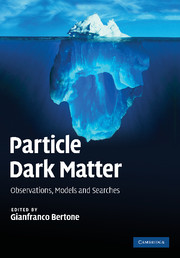Book contents
- Frontmatter
- Contents
- List of contributors
- Preface
- Acknowledgements
- List of symbols and abbreviations
- Part I Dark matter in cosmology
- Part II Candidates
- Part III Collider searches
- Part IV Direct detection
- 17 Direct detection of WIMPs
- 18 Annual modulation signature with large mass highly radiopure NaI(Tl)
- 19 Particle dark matter and the DAMA/NaI and DAMA/LIBRA annual modulation effect
- 20 Cryogenic detectors
- 21 Liquid noble gases
- 22 Directional detectors
- 23 Axion searches
- Part V Indirect detection and astrophysical constraints
- References
- Index
22 - Directional detectors
Published online by Cambridge University Press: 04 August 2010
- Frontmatter
- Contents
- List of contributors
- Preface
- Acknowledgements
- List of symbols and abbreviations
- Part I Dark matter in cosmology
- Part II Candidates
- Part III Collider searches
- Part IV Direct detection
- 17 Direct detection of WIMPs
- 18 Annual modulation signature with large mass highly radiopure NaI(Tl)
- 19 Particle dark matter and the DAMA/NaI and DAMA/LIBRA annual modulation effect
- 20 Cryogenic detectors
- 21 Liquid noble gases
- 22 Directional detectors
- 23 Axion searches
- Part V Indirect detection and astrophysical constraints
- References
- Index
Summary
Direct dark matter detection technologies and directionality
The direct detection technologies described in Chapters 18, 20 and 21 are motivated mainly by a desire actively to distinguish hypothesized WIMP-induced nuclear recoil events from backgrounds such as electron recoils. In each case this is achieved by attempting to measure a quantity, or ratio of quantities, such as heat to light, that depends on the dE/dx of the particle. This raises the question, why not measure the dE/dx directly itself, that is, measure the energy loss distribution along the recoil tracks? Achieving this in a suitable medium, for instance by imaging the tracks in some way, could provide the maximum possible information on events, not just the dE/dx and Bragg curve but also the range and perhaps the absolute direction of the recoiling nucleus.
This is the objective of directional WIMP detectors discussed here. However, the advantage of directional sensitivity is not just the prospect of reaching the best feasible discrimination and particle identification, possible because there is no doubt that different species with the same recoil energy will have different ranges for instance, but more importantly the prospect of linking the direction of those recoils to our motion through the Galaxy. This would provide a clear route towards a signature based on the non-terrestrial nature of WIMPs, a potentially definitive signature for WIMPs as dark matter, with maximum model-independency from particle physics and cosmology assumptions.
- Type
- Chapter
- Information
- Particle Dark MatterObservations, Models and Searches, pp. 437 - 466Publisher: Cambridge University PressPrint publication year: 2010

